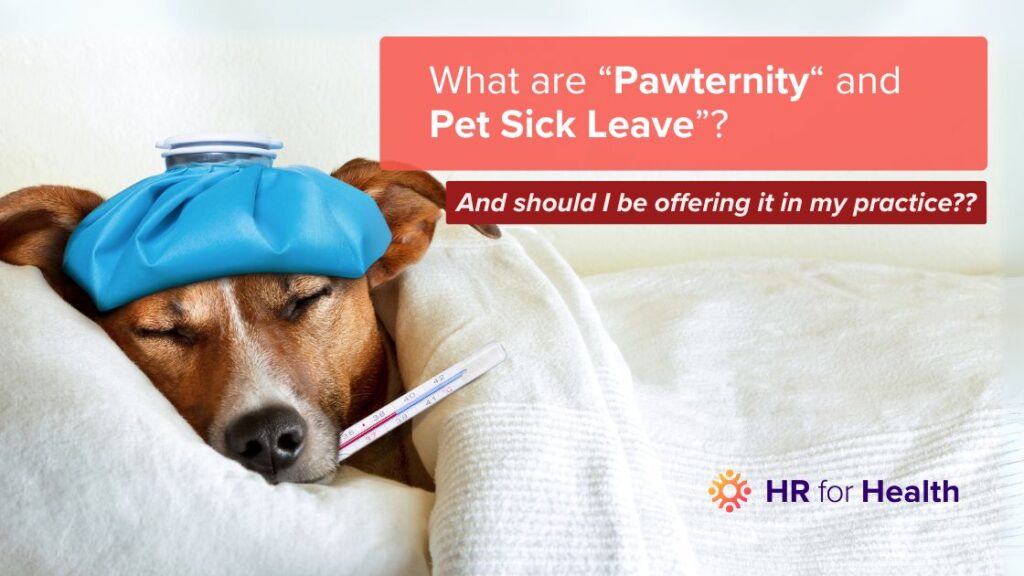We’re fielding more questions than ever about using sick leave for vet visits, puppy bonding, or grieving a beloved pet which is frequently known as “Pawternity Leave” or Pet Sick Leave. Employees increasingly see animals as family, and they want benefits that respect that bond. Yet, healthcare practices must also keep exam rooms staffed and patients safe. At HR for Health, we will show how to balance compassion with compliance so everyone’s tails keep wagging.
Why Pet Leave Is Suddenly on Your Radar
Pawternity leave requests didn’t appear overnight; they’re the product of social, economic, and generational shifts. Understanding the “why” will guide whether and how you adapt your leave program. A few reasons why pet sick leave has become a major issue include:
- Pandemic pet boom. Millions of people adopted animals during lockdowns, and those pets now require routine and emergency care. Practices are hearing the ripple effects in PTO requests.
- Millennial & Gen Z priorities. Younger employees often delay parenthood, pouring time and money into pets instead. They appreciate workplaces that acknowledge that commitment.
- Mental‑wellness focus. Caring for an ill animal or mourning a loss can significantly affect performance. Time off preserves productivity and reduces burnout.
- Competitive hiring. Clinics and dental offices use unique perks to stand out; pet leave joins childcare subsidies and mental‑health days on hiring offer letters.
- Social media amplification. Viral stories of “pawternity” benefits elsewhere raise awareness and spur employees to ask, “Why not us?”
Ignoring these drivers risks turnover and morale issues. Addressing them proactively shows empathy while keeping policy boundaries clear.
Current Legal Landscape: No Mandate, High Risk
Most federal and state laws are silent on pets, meaning employers may decide whether to grant leave, but must do so consistently. If a practice offers paid sick time, it can limit use to human family care without breaking any rule, yet uneven approvals expose it to discrimination claims. Clear, uniformly applied language is the safest route.
Healthcare settings face unique stakes: understaffing not only hurts co‑workers; it jeopardizes patient outcomes and compliance with state staffing ratios. A single unscheduled absence can cascade into overtime costs or appointment backlogs. Therefore, any pet sick leave accommodation must dovetail with robust coverage plans.
Finally, employers must distinguish between typical pets and trained service animals under the ADA. While caring for a dog that guides a visually impaired employee may qualify as a reasonable accommodation, routine puppy socialization likely does not. Treating these scenarios alike can create legal pitfalls.
Pending Legislation & Trend‑Watching
Cities known for progressive labor rules like Portland, Pittsburgh, and Madison have floated proposals to fold pet care into paid sick‑leave ordinances. Though none have passed, momentum is building, and local advocacy groups continue to lobby legislators. Staying ahead of these shifts prevents last‑minute handbook overhauls.
Nationally, industry coalitions are studying how pet leave affects productivity and turnover. Early findings suggest minimal cost when integrated into existing PTO banks. Data like this may encourage broader legislative adoption, underscoring the need for proactive planning.
Pros & Cons of Offering Pet Leave Benefits
Offering pawternity perks isn’t always a slam‑dunk. Before revising policy, weigh the upside and potential drawbacks.
Advantages
- Talent magnet. Pet‑friendly benefits help recruit veterinarians, hygienists, and techs in a tight labor market.
- Higher retention. Employees who feel valued stay longer, lowering onboarding expenses.
- Cultural alignment. Healthcare workers are naturally nurturing, providing pet care benefits aligns with that ethos.
- Low incremental cost. Folding pet hours into current PTO rarely spikes payroll.
- Positive PR. The media loves stories about progressive benefits, boosting your practice brand.
- Manageable with software. If you are using leave tracking software, adding a new category doesn’t create a significant administrative burden.
Drawbacks
- Scheduling strain. Small teams struggle to backfill on short notice, creating issues for employee scheduling.
- Perceived inequity. Staff without pets might feel overlooked, damaging morale.
- Policy creep. Vague rules invite requests for reptiles, farm animals, or pet anniversaries.
- Administrative burden. Adding a new leave category requires tracking updates and manager training.
Policy Design Options for Healthcare Practices
Pet leave isn’t one‑size‑fits‑all. Choose a framework that matches your size, culture, and patient‑care obligations. A few options to keep in mind include:
Incorporate Pets Into Existing Sick Leave
Fold a limited number of pet‑care hours into the sick‑leave bucket that employees already accrue. Staff can use that time for vet appointments, surgery pickup, or hospice goodbyes without adding a new benefit line. This keeps payroll predictable and minimizes employee handbook edits.
Because the pool is finite, employees self‑moderate: taking hours for a dog’s ACL repair means fewer hours for personal illness. Managers simply approve requests through the current system, and HR tracks usage under the existing leave code. That simplicity lowers rollout friction.
Create a Separate “Pawternity” Bucket
Allot one to three paid days per year for new‑pet bonding, major medical procedures, or bereavement. Some HRIS platforms, like HR for Health, easily accommodate these changes which provide clean reporting, aiding future cost–benefit reviews. Employees appreciate the dedicated time and feel less pressure to hoard PTO.
Clarify eligibility: Only domesticated cats, dogs, or rabbits are eligible; proof of adoption or veterinary receipt is required. A waiting period (e.g., 90 days of employment) prevents abuse. Leadership can sunset the pilot after a year if utilization or coverage proves unmanageable.
Offer Unpaid, Job‑Protected Pet Sick Leave
Mirroring FMLA, this option secures an employee’s role for up to five unpaid days annually. It safeguards staffing budgets while granting empathy for significant pet events. Requiring a 48‑hour notice, where feasible, lets managers arrange coverage.
Define qualifying circumstances like surgery, severe illness, or end‑of‑life care to avoid slippery slopes. Documentation (vet letter) protects against frivolous claims. By limiting duration, practices maintain patient service levels without permanent payroll increases.
Implementation Checklist
Rolling out pawternity leave takes coordination and clarity. It is important to make sure that nothing is overlooked. A few items that should be on your checklist include:
- Gather stakeholder input. Survey employees and leadership to gauge interest and concerns. Use results to tailor policy scope.
- Define eligible animals. Limit the eligible animals to common household pets to prevent exotic‑pet complexities. Clearly state exclusions.
- Set documentation rules. Adoption papers or vet notes verify legitimacy. This deters misuse and simplifies manager decisions.
- Amend the handbook. Align new leave with attendance, PTO, and disciplinary sections. Distribute updated copies promptly.
- Implement new process. Whether you are using digital PTO tracking or manual systems for tracking and reporting you’ll need to update your current process to accommodate the new category
- Educate managers. Provide talking points and scenario guides to enforce policy consistently. Emphasize coverage procedures.
- Monitor and review. After six months, evaluate pawternity leave utilization, scheduling impact, and employee feedback. Adjust thresholds if needed.
Consistent application keeps morale high and shields against claims of favoritism. A clear paper trail simplifies future audits.
Communication Strategies That Prevent Misunderstandings
A solid policy fails without effective rollout and reinforcement. Key communication strategies to keep in mind include:
- Launch announcement. Explain the “why,” eligibility, and request steps in plain language. Include FAQs.
- Staff meeting demo. Walk through the request process live. Invite questions on the spot.
- Visual quick‑guide posters. Post in break rooms with key dos and don’ts. Visual aids reduce confusion.
- Quarterly reminders. Incorporate pet‑leave tips in newsletters or intranet banners. This keeps policy top‑of‑mind.
- Manager check‑ins. Encourage supervisors to discuss pet‑leave planning during one‑on‑ones to promote proactive scheduling.
Close each communication with a link to the full handbook section. Repetition cements understanding and reduces last‑minute surprises.
Ready to Craft Your Pet Sick Leave Policy? Partner With HR for Health
Pet benefits have moved from non-existent to strategic differentiator, especially in caring professions like yours. At HR for Health, our platform tracks unique leave types, automates handbook updates, and alerts you to legal changes before they bite. Let’s design a policy that protects patients, supports employees, and keeps your practice compliant. Schedule a free consultation today, and turn pawternity leave into a competitive advantage.


